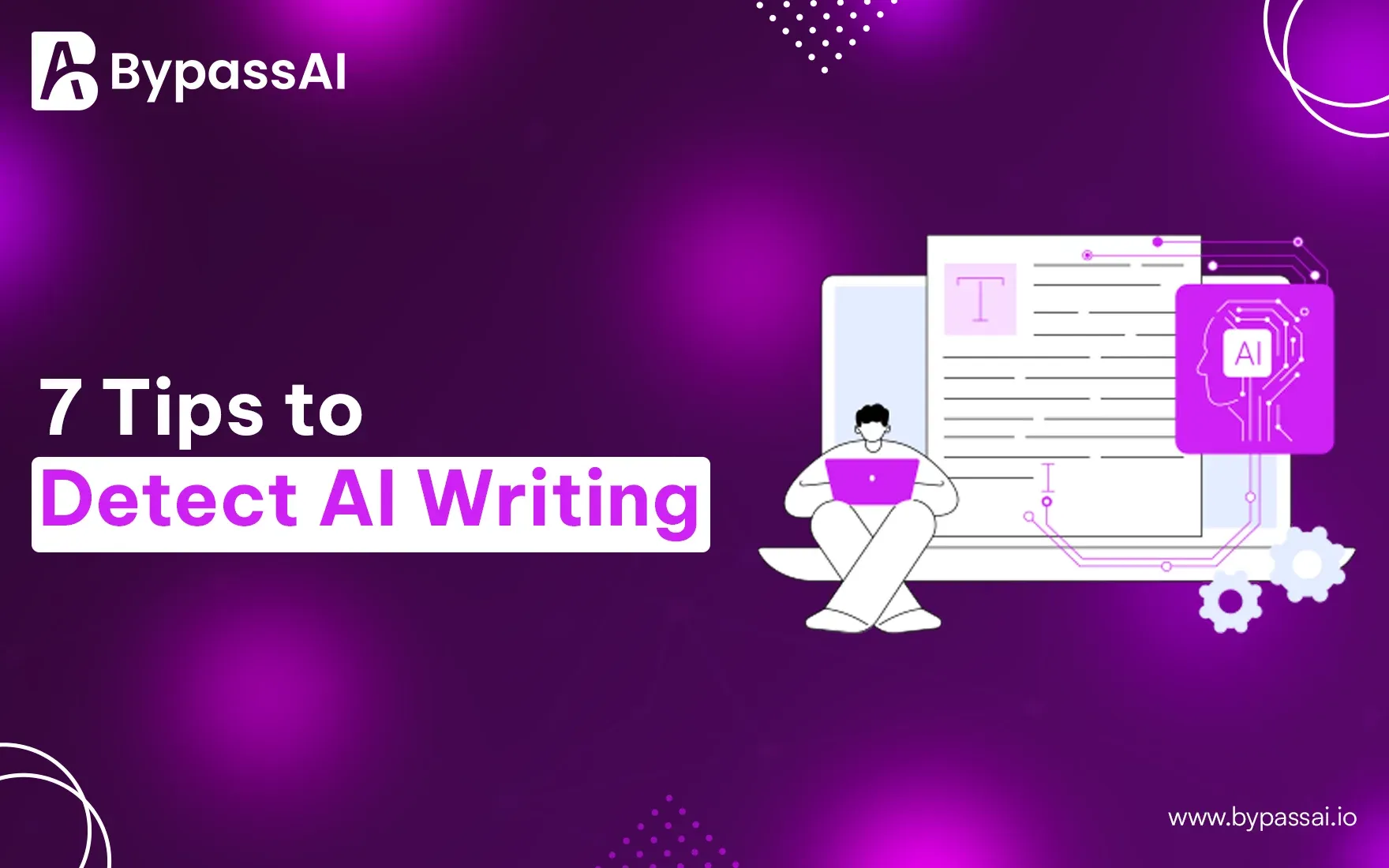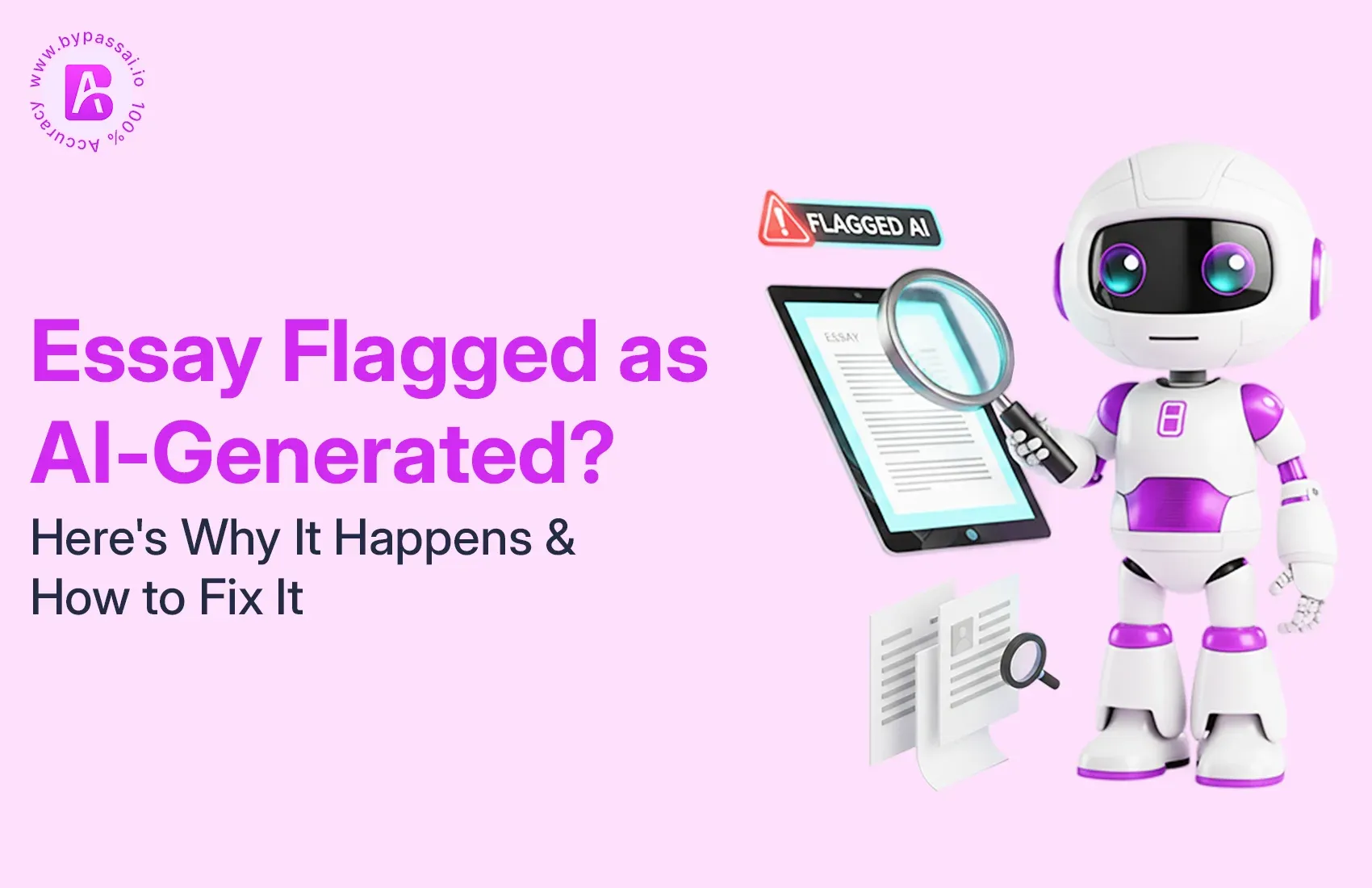Sign In
Welcome to Bypass AI! Sign in to continue your exploration of our platform with all its exciting features.
Forgot Password?
Don’t have an account ? Sign up
Sign Up
Embrace the Future with Bypass AI! Sign up now and let's rewrite the possibilities together.
You have an account ? Sign In
Enter OTP
We’ll send you an OTP on your registered email address
Back to Login
Forgot Password
We'll Send You An Email To Reset Your Password.
Back to Login
Enter OTP
We'll send you an email to reset your password.
Back to Login
Confirm Password
Please enter your new password.
TABLE OF CONTENTS
Quick Summary
What are AI Content Detection Tools?
How do they work?
Do AI content detectors have perfect accuracy?
Does Google Accept AI-generated Content?
Top 7 Tips to Make AI-Generated Content Undetectable
Conclusion
FAQs
AI-generated content has become increasingly common across various digital platforms with the rapid advancements in artificial intelligence. However, as the presence of AI-written text grows, so does the need for detection tools to distinguish between human and AI generated content. This has led to the development of AI content detection tools designed to ensure transparency and authenticity in the content we consume.
Quick Summary
AI content detection tools are designed to identify whether a piece of content was written by a human or generated by an AI. These tools use various algorithms and techniques to analyze the structure, style, and patterns in the text. Despite their growing sophistication, these tools are not infallible. This guide will explore how to avoid AI detectors, how AI content detectors work, their accuracy, Google's stance on AI-generated content, and provide top tips to make AI-generated content less detectable.
What are AI Content Detection Tools?
In plain terms, AI systems that identify content look at the words used to figure out if a person or a machine wrote it. They check out language choice, sentence builds, grammar rules, and how hard or easy to read the text is. These are some features that the tech might eyeball.
When looking at the words chosen and the level of text difficulty, the tool might decide if an AI, such as ChatGPT or Jasper, penned a piece. AI-generated text can be more pattern-like and redundant than human-written work. Plus, it demands greater intricacy and nuance in human language.
Often, text crafted by AI may slip in small mistakes or discrepancies not usually found in human-written pieces. Conversely, when words are penned by a human, AI-based detectors might discover this by examining diverse language and style characteristics in the text.
How do they work?
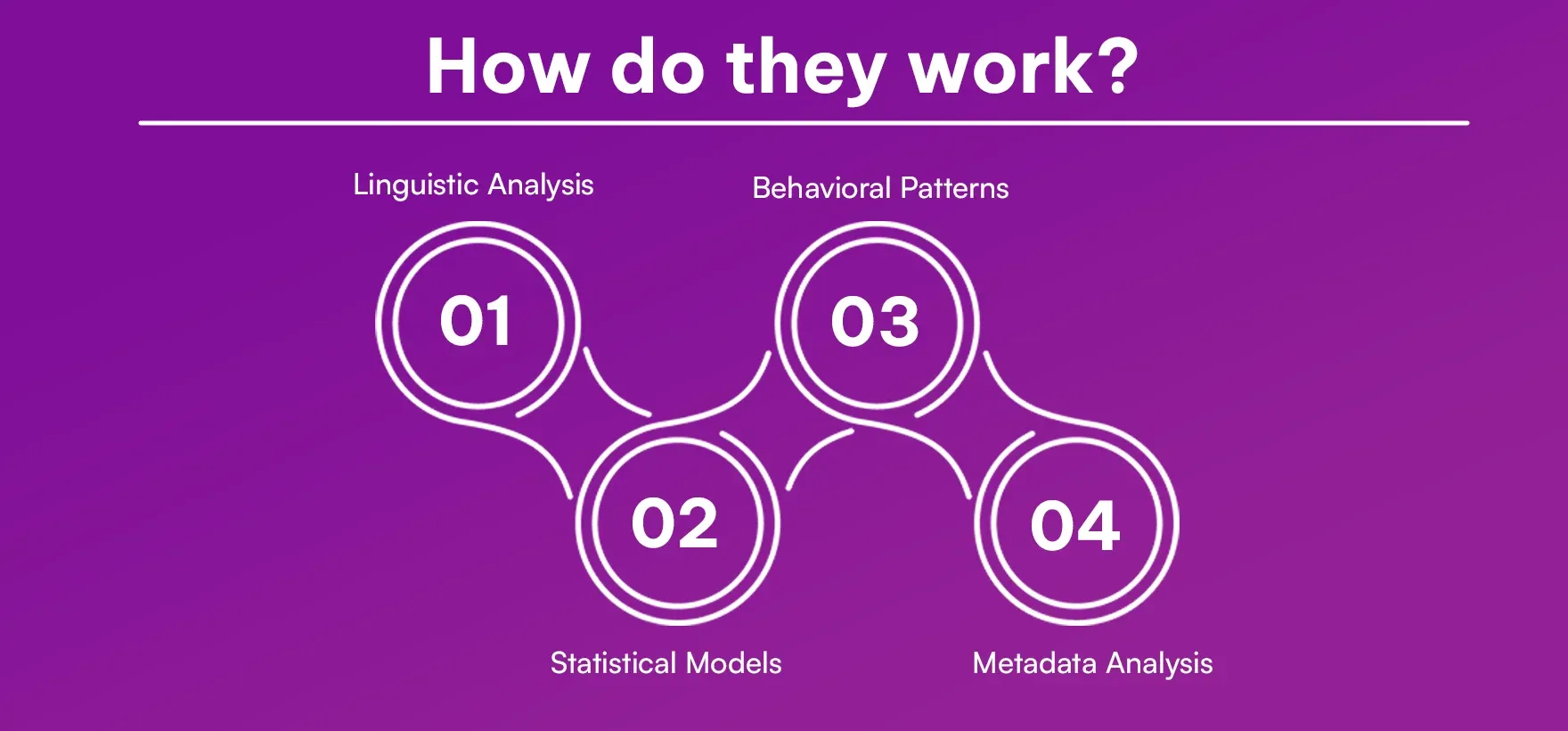
AI content detectors work by employing various techniques:
Linguistic Analysis: Examining the syntax, grammar, and vocabulary used in the text to spot irregularities or patterns that are common in AI-generated content.
Statistical Models: Using machine learning models trained on large datasets of both human and AI-written text to identify subtle differences in writing styles.
Behavioral Patterns: Analyzing the behavior of the content, such as repetition of certain phrases, unnatural flow, or overuse of specific keywords that might indicate AI involvement.
Metadata Analysis: Looking at metadata such as writing speed, time stamps, and editing history to infer whether the content could have been generated by AI.
Also read this article : How Do AI Detectors Work?
Do AI content detectors have perfect accuracy?
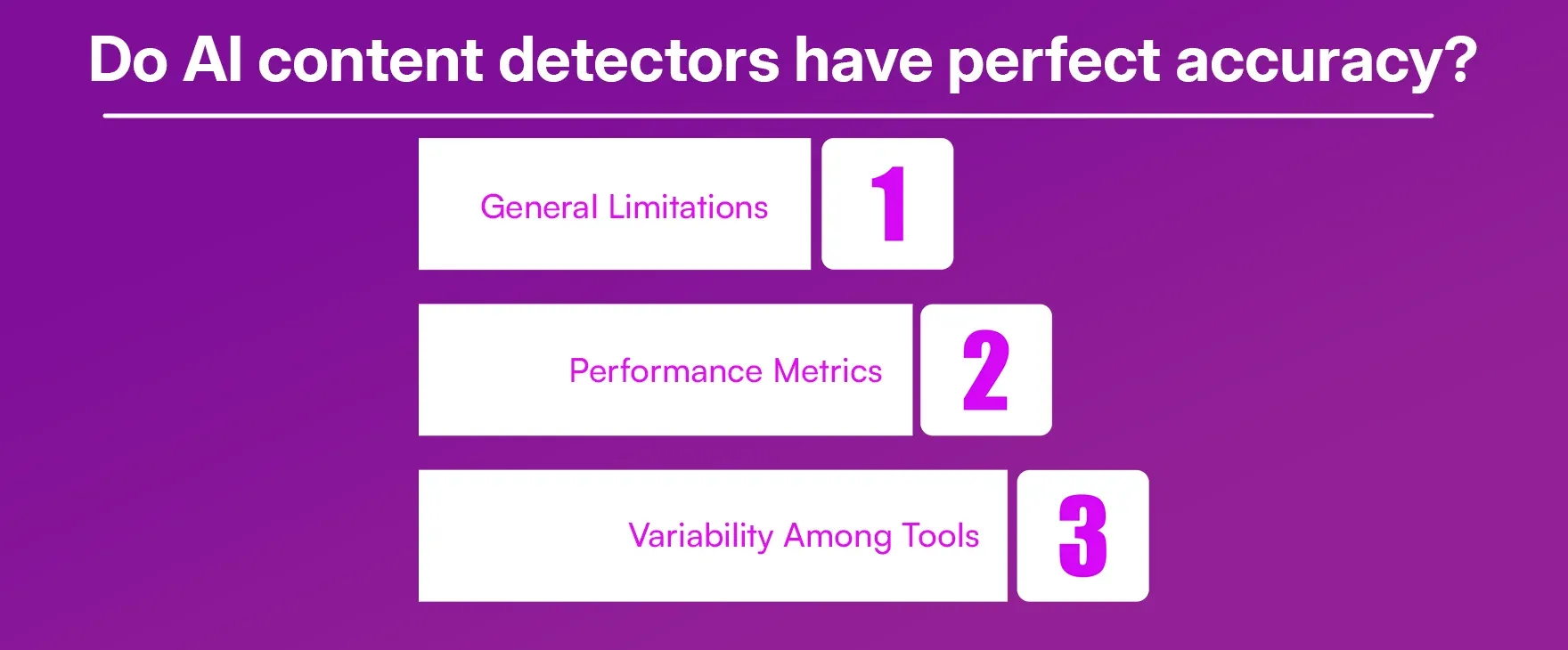
AI content checkers aren't foolproof. A couple of things affect how well they work. This includes how the tech naturally performs and the ways it's built.
Accuracy Levels
General Limitations: AI scanners work by using chances and trends from training materials made up of human and AI-created writings. They give us good guesses, not absolute truths. This means they can't always be right, 100% of the time. Sometimes, they goof up and label human writing as AI-made (false positive). Other times, they miss the mark and don't pick up on the AI-written stuff (false negative).
Performance Metrics:Research indicates that the typical accuracy rate for different AI detectors is about 60%. The top ones can achieve up to 84% precision. Despite this, there's still room for errors, particularly in sophisticated or intricate works.
Variability Among Tools:Various AI filters use unique data-sets and formulae. This creates different outcomes across services. While some may do well in certain situations, they might not in others. This makes the dependability of a single filter complicated.
Does Google Accept AI-generated Content?
The views of Google on content created by artificial intelligence are intricate. The leading search engine may not completely ban text produced by AI, but it emphasizes the need for richness and merit in the content it registers. Google honors content that assists, educates, or amuses the audience—it doesn't matter if humans or artificial intelligence created it.
But, to make AI-created content fit these standards, we must improve it to offer genuine worth. It involves merging detailed studies, special viewpoints, and a custom method that strikes a chord with human readers.
Top 7 Tips to Make AI-Generated Content Undetectable
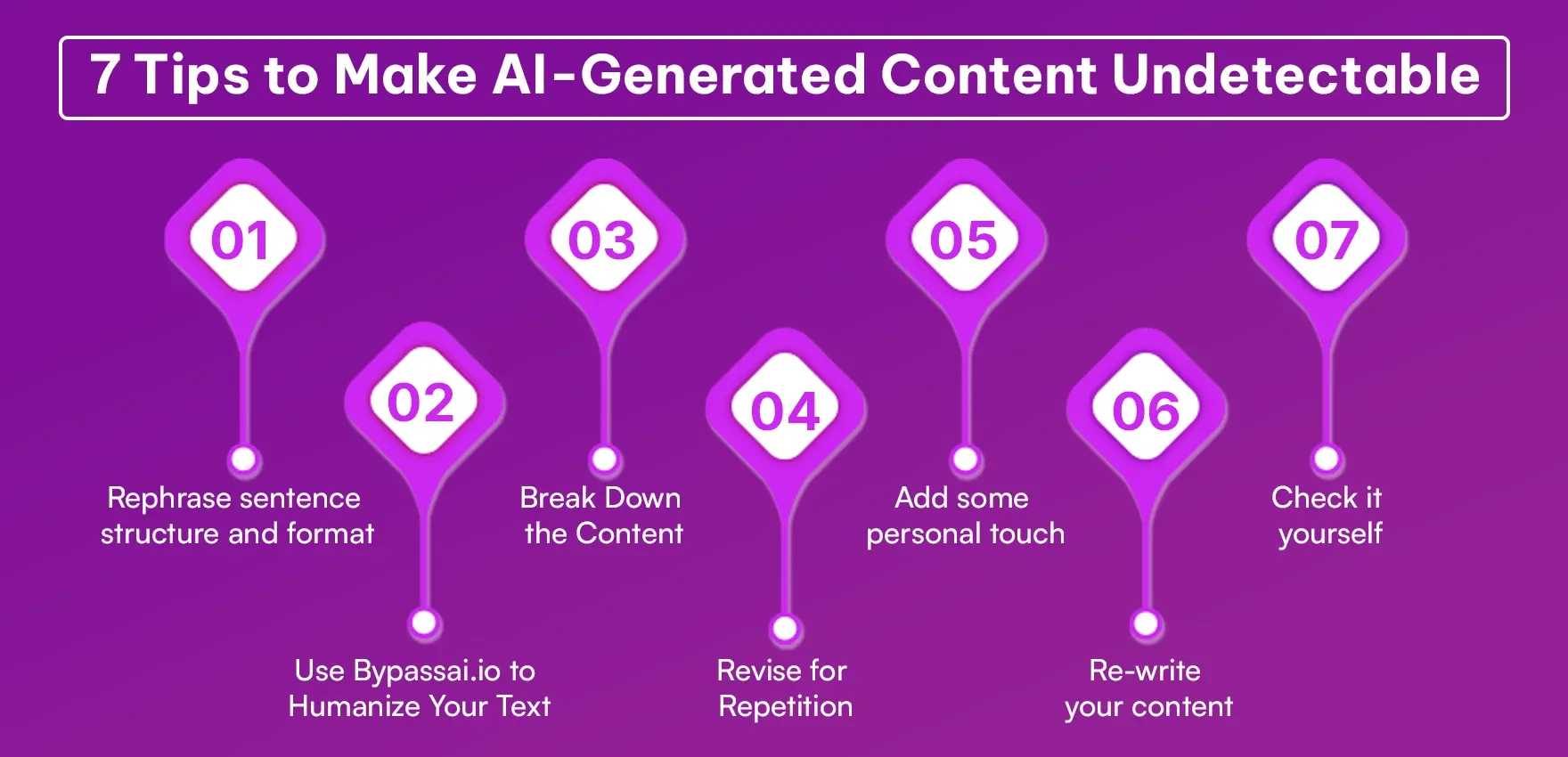
1. Rephrase sentence structure and format
AI-made content tends to stick to certain patterns. To give your text a more human touch, mix up your sentence lengths and styles. Try blending simple, compound, and complex sentences. You could also switch up the sequence of info in your sentences. Start with a part of a sentence that isn't normally at the start, like a phrase or a clause. This jumbling adds a more natural feel and makes the text less likely to be noticed as AI-written.
2. Use BypassAI IO to Humanize Your Text
BypassAI IO is a handy gadget intended for folks wanting AI-manufactured text to sound more human. It sifts through your text and provides advice to amplify the flow and emotional pull of the material. By utilizing such instruments, you can pinpoint places where the text seams automated or excessively stiff. Infuse the recommended alterations to interject liveliness and character into your work, ensuring it resonates better with your audience.
3. Break Down the Content
AI text often comes in big chunks. Chop it up! Make your content snackable. Like how humans do it. Small ideas, easy to understand. Break it up with mini titles. This shows readers the path through your story or point of view.
4. Revise for Repetition
Content made by AI might show repeated thoughts or words. To boost uniqueness, go through your sentences and look for any repetition. Swap repeated words with different ones that mean the same, and confirm to make your points bringing in value to the entire conversation. This will not only uplift the standard of your writing but additionally bring down the chance of it being marked as powered by AI.
5. Add some personal touch
Adding your own tales, views, or life moments can give a more human feel to your work. People bond better with pieces that show real feelings and singular points of view. Give examples or knowledge related to the subject you're addressing, and don't be afraid to say what you think. This personal emphasis not only makes your work more intriguing, but it also sets it apart from standard AI creations.
6. Re-write your content
When using AI to create text, spend some time revamping large parts of it. This isn't about small tweaks; think major word swaps and sentence rhythm changes. Sometimes, you might even shift the whole story or argument. Doing this not only makes the text less identifiable as machine-made, but it also gives you the chance to weave your unique voice and flair into it.
7. Check it yourself
Don't forget to check your content before you share it. Speaking it aloud helps find weird phrases or odd rhythms. Try using stuff like grammar correction tools or readability assessors to tidy up your writing. Plus, getting thoughts from pals helps you gauge if your content rings true to other people. This bit is key to making sure what you put out is genuine and interesting.
Conclusion
AI-created writing is everywhere, but it can be hard to keep it real and unique. Even if tools like the AI Content Detector can spot AI text, they aren't perfect. They might miss stuff only a human would add, or think a human piece is AI-made. We can be more sneaky with AI text. Change up your sentences, simplify things, and add that human touch. This can make AI feel less robotic and more alive. It's all about keeping the audience hooked. Where your words came from doesn't matter, what counts is trust. Your writing should be believable!
FAQs
1. What are the identification tools in AI?
AI object recognition systems analyze text structure, style, and style to determine whether human authors or AI authors.
2. How accurate are AI content detectors?
The accuracy of AI content detectors varies, with most achieving 60-84% accuracy. They are not infallible and can sometimes misidentify the source of a text.
3. Does Google reject AI-created content?
Google doesn’t completely ban AI-designed content but emphasizes the need for content that is valuable, helpful and interesting regardless of its origin.
4. What are some common characteristics of AI products?
Common symptoms include repetitive sentences, unnatural flow, overuse of specific key words, and lack of personal touch or subtle speech.
5. How do I make AI-generated objects less visible?
You can make AI-generated text less predictable by redefining sentences, parsing text, adding your own words, and revising it for repetition and readability

